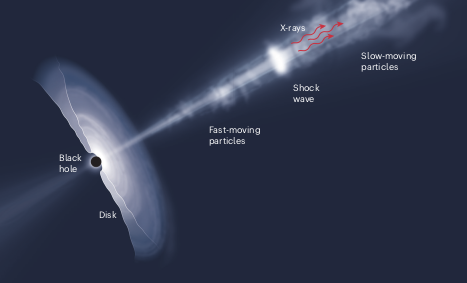Beams of electrons smash into slower-moving particles causing a shock wave which results in electromagnetic radiation across frequency bands from X-rays to visible light, according to a research paper published in Nature this week.
Astronomers first observed quasi-stellar radio sources or quasars in the early 1960s. This new class of astronomical objects was a puzzle. They looked like stars, but they also radiated very brightly at radio frequencies, and their optical spectra contained strange emission lines not associated with “normal” stars. In fact, these strange objects are gigantic black holes at the center of distant galaxies.

Particle acceleration in the jet emitted by a supermassive black hole. Illustration credit: Liodakis et al/Nature
Advances in radio-astronomy and X-ray-observing satellites have helped scientists understand that the anomalous radiation is caused by a stream of charged particles accelerated close to the speed of light. If it points at Earth, the generating quasar can be called a blazar. Electromagnetic radiation from them can be observed from radio waves through the visible spectrum to very high-frequency gamma rays.
[…]
By comparing polarized X-rays data with data about optical polarized visible light, the scientists reached the conclusion that the electromagnetic radiation resulted from a shock wave in the stream of charged particles emitting from the blackhole (see figure).
In an accompanying article, Lea Marcotulli, NASA Einstein Postdoctoral Fellow at Yale University, said: “Such shock waves occur naturally when particles travelling close to the speed of light encounter slower-moving material along their path. Particles traveling through this shock wave lose radiation rapidly and efficiently – and, in doing so, they produce polarized X-rays. As the particles move away from the shock, the light they emit radiates with progressively lower frequencies, and becomes less polarized.”
[…]
In December last year, a SpaceX Falcon 9 rocket launched NASA’s IXPE mission into orbit from Florida’s Kennedy Space Center. It is designed to observe the remnants of supernovae, supermassive black holes, and other high-energy objects.
[…]
Source: Bright light from black holes caused by particle shock waves • The Register

Robin Edgar
Organisational Structures | Technology and Science | Military, IT and Lifestyle consultancy | Social, Broadcast & Cross Media | Flying aircraft
